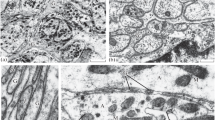Abstract
Neurons from the peripharyngeal nerve ring detached from the pteropodial molluskClione limacina were cultured in polylysine prepared in a 25% Leibovitz saltwater medium containing 2% embryonic calf serum. Neurite outgrowth was observed in a proportion of the neurons, reaching its peak rate during the first three days. Neurites grew up to 300 µm in length. Membrane potential of the neurons measured 40–60 mV. The latter generated either single action potentials or volleys of spikes. Neural connections between 70 pairs of cells with overlapping neurites were investigated on days 3–4. An electrical connection was discovered between cells in 20% of the pairs examined and, in 6%, stimulating one neuron of a pair produced an inhibitory postsynaptic potential in the other.
Similar content being viewed by others
Literature cited
Yu. I. Arshavskii, I. N. Beloozerova, G. N. Orlovskii, et al., "Activity of motoneurons in pteropod mollusk pedal ganglia during generation of a locomotor rhythmic firing pattern," Neirofiziologiya,16, No. 2, 269–271 (1984).
Yu. I. Arshavskii, I. N. Beloozerova, G. N. Orlovskii, et al., "Activity of interneurons in pteropod mollusk pedal ganglia during generation of a locomotor rhythmic firing pattern," Neirofiziologiya,16, No. 2, 272–275 (1984).
Yu. I. Arshavskii, I. M. Gel'fand, and G. N. Orlovskii, "Regeneration of pedal ganglia neurons in the pteropod molluskClione limacina," Neirofiziologiya,17, No. 4, 449–455 (1985).
B. N. Veprintsev, V. I. Geletyuk, and M. A. Kostenko, "Culturing nerve cells from the mollusksLymnaea stagnalis andHelix pomatia," in: Guide to Nerve Tissue Culture [in Russian], (V. I. Veprintsev, ed.) Nauka, Moscow (1976), pp. 190–209.
V. I. Geletyuk, "Growth of axons and formation of functional neural connection in vitro in detached neurons from the adult molluskLymnaea stagnalis," Dokl. Akad. Nauk SSSR,233, No. 5, 989–992 (1977).
M. A. Kostenko, V. S. Musienko, and T. I. Smolikhina, "Altered intracellular ionic homeostasis during stimulation of neurite outgrowth in neurons isolated from the mollusk in culture," Tsitologiya,21, No. 11, 1319–1325 (1979).
M. A. Kostenko, V. S. Musienko, and T. I. Smolikhina, "Effects of pH and intracellular Ca concentration on neurite outgrowth in mollusk neurons in culture," Tsitologiya,23, No. 7, 779–787 (1981).
M. A. Kostenko and N. N. Tret'yak, "Morphological differentiation in detached mollusk giant neurons in culture," Tsitologiya,20, No. 10, 1126–1134 (1978).
Yu. V. Panchin, "Synchronization in the operation of pteropod mollusk pedal ganglia during locomotion," Neirofiziologiya,16, No. 4, 540–543 (1984).
Yu. I. Arshavsky, I. N. Beloozerova, G. N. Orlovsky, et al., "Control of locomotion in the marinemolluskClione limacina. 1. Efferent activity during actual and fictitious swimming," Exp. Brain Res.,58, No. 2, 255–262 (1985).
Yu. I. Arshavsky, I. N. Beloozerova, G. N. Orlovsky, et al., "Control of locomotion in the marine molluskClione limacina. 2. Rhythmic neurons of pedal ganglia," Exp. Brain Res.,58, No. 2, 263–272 (1985).
Yu. I. Arshavsky, I. N. Beloozerova, G. N. Orlovsky, et al., "Control of locomotion in the marine molluskClione limacina. 3. On the origin of locomotory rhythm," Exp. Brain Res.,58, No. 2, 273–284 (1985).
R. Bodmer, D. Dagan, and I. B. Levitan, "Chemical and electrotonic connections betweenAplysia neurons in primary culture," J. Neurosci.,4, No. 1, 228–233 (1984).
C. S. Cohan, R. D. Hadley, and S. B. Kater, "‘Zap axotomy’: localised fluorescent excitation of single dye-filled neurons induces growth by selective axotomy," Brain Res.,270, No. 1, 93–101 (1983).
J. S. Camardo, E. Proshansky, and S. Schacher, "IdentifiedAplysia neurons from specific chemical synapses in culture," J. Neurosci.,3, No. 12, 2614–2620 (1983).
P. A. Fuchs, L. P. Henderson, and J. G. Nicholls, "Chemical transmission between individual Retzius and sensory neurones of the leech in culture," J. Physiol.,323, 195–210 (1982).
R. D. Hadley, S. B. Kater, and C. S. Cohan, "Electrical synapse formation depends on interaction of mutually growing neurites," Science,221, No. 4609, 466–468 (1983).
A. D. Murphy and S. B. Kater, "Specific reinnervation of a target organ by a pair of identified molluskan neurons," Brain Res.,156, No. 2, 322–328 (1978).
A. D. Murphy and S. B. Kater, "Sprouting and functional regeneration of an identified neuron inHelisoma," Brain Res.,186, No. 2, 251–272 (1980).
R. G. Wong, D. L. Barker, S. B. Kater, and D. A. Bodnar, "Nerve growth-promoting factor produced in culture media conditioned by specific CNS tissues of the snailHelisoma," Brain Res.,292, No. 1, 81–91 (1984).
R. G. Wong, R. D. Hadley, S. B. Kater, and G. C. Hauser, "Neurite outgrowth in molluskan organ and cell cultures: the role of conditioning factor(s)," J. Neurosci.,1, No. 9, 1008–1021 (1981).
R. G. Wong, E. C. Martel, and S. B. Kater, "Conditioning factor(s) produced by several molluskan species promote neurite outgrowth in cell culture," J. Exp. Biol.,105, 389–393 (1983).
Additional information
Institute of Information Transmission Research, Academy of Sciences of the USSR, Moscow. M. V. Lomonosov Moscow State University. Translated from Neirofiziologiya, Vol. 19, No. 1, pp. 81–86, January–February, 1987.
Rights and permissions
About this article
Cite this article
Arshavskii, Y.I., Gel'fand, I.M., Delyagina, T.G. et al. Neurite growth and formation of connections in pteropodial mollusk neurons in culture. Neurophysiology 19, 70–75 (1987). https://doi.org/10.1007/BF01055998
Received:
Issue Date:
DOI: https://doi.org/10.1007/BF01055998




